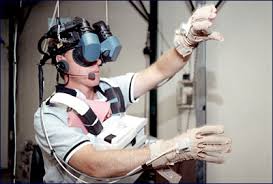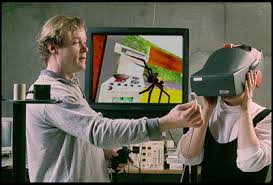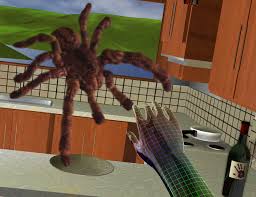Lesson 3: Treatment
Virtual Reality Therapy
 Not long ago, virtual reality therapy was used only in science fiction movies. Still in its early phase, this form of therapy appears to be quite promising - not only for those with physical disabilities, but for those with mental disabilities as well. The basis behind this form of treatment is the notion that an effective way to reduce pain, whether emotional or physical, is to distract the person with something else. The “something else” in this case, is a computer-generated “virtual” experience.
Not long ago, virtual reality therapy was used only in science fiction movies. Still in its early phase, this form of therapy appears to be quite promising - not only for those with physical disabilities, but for those with mental disabilities as well. The basis behind this form of treatment is the notion that an effective way to reduce pain, whether emotional or physical, is to distract the person with something else. The “something else” in this case, is a computer-generated “virtual” experience.
All pain, even physical pain, has a powerful psychological component. A pain signal can be interpreted as either more or less painful depending on the mindset of the individual. Virtual therapy is designed to totally immerse patients in another world – to effectively modify their mindsets. In one experiment involving burn victims, patients were distracted with Nintendo games during one treatment and a virtual reality spider phobia program in the second treatment. Even though the burn victims did not have spider phobias (arachnophobia) as the virtual program was designed for, they reported a dramatic decrease in pain while immersed in the two-dimensional virtual world. Other studies confirmed these results and noted that virtual therapy is far more effective than other therapies used with burn victims – even traditional pain control with opioid drugs.
In other trials using virtual technology, burn victims participated in a “ChocolateWorld” scenario. In this program they were able eat a real chocolate bar and “see” the bite marks appear in the virtual chocolate bar! This form of distraction proved quite effective in their pain management. Regarding psychological pain, virtual reality therapy is being used in the treatment of phobias including fear of heights, fear of flying, fear of speaking in public, post traumatic stress disorder, and fear of spiders (Hunter Hoffman, 2004).
In another example, a woman with arachnophobia was willing to try virtual therapy (summarized from  Scientific American, August 2004). The woman had acquired a number of obsessive-compulsive behaviours linked to her phobia. For example, she regularly used pesticides in her vehicle and at home to eradicate any spiders that lived there. She sealed her bedroom windows with duct tape to prevent any spiders from entering her house from the outside. She sealed freshly laundered clothing in plastic bags to prevent “contamination” from spiders. Her condition worsened, so much so that she was hesitant to leave her house. After 20 years of coping with her phobia, she eventually sought help.
Scientific American, August 2004). The woman had acquired a number of obsessive-compulsive behaviours linked to her phobia. For example, she regularly used pesticides in her vehicle and at home to eradicate any spiders that lived there. She sealed her bedroom windows with duct tape to prevent any spiders from entering her house from the outside. She sealed freshly laundered clothing in plastic bags to prevent “contamination” from spiders. Her condition worsened, so much so that she was hesitant to leave her house. After 20 years of coping with her phobia, she eventually sought help.
Similar to other types of treatment, virtual reality therapy may employ systematic desensitization  techniques to help individuals. Regarding our spider-phobic woman, the virtual reality treatment involved gradually introducing her to a virtual spider. Progressively the fear decreased and then she became more comfortable. In the first few sessions of virtual therapy, the woman saw a virtual spider in a virtual kitchen. She approached as close as possible (using a handheld joystick to navigate through the three-dimensional scene) with a goal to come within a metre of the virtual spider. Eventually her goal was to reach for the spider while wearing a special glove that tracked the position of her hand. The spider was then to make a brief noise and flee a few inches away from the “cyberhand”. The women was then instructed to pick up a virtual vase with her cyberhand. When she let go of the vase, the vase remained in midair but an animated spider with wiggling legs came out. The spider then drifted to the floor of the virtual kitchen, accompanied by a brief sound effect from the classic horror movie Psycho. The patient then repeated similar tasks until she reported little anxiety surrounding the virtual spiders.
techniques to help individuals. Regarding our spider-phobic woman, the virtual reality treatment involved gradually introducing her to a virtual spider. Progressively the fear decreased and then she became more comfortable. In the first few sessions of virtual therapy, the woman saw a virtual spider in a virtual kitchen. She approached as close as possible (using a handheld joystick to navigate through the three-dimensional scene) with a goal to come within a metre of the virtual spider. Eventually her goal was to reach for the spider while wearing a special glove that tracked the position of her hand. The spider was then to make a brief noise and flee a few inches away from the “cyberhand”. The women was then instructed to pick up a virtual vase with her cyberhand. When she let go of the vase, the vase remained in midair but an animated spider with wiggling legs came out. The spider then drifted to the floor of the virtual kitchen, accompanied by a brief sound effect from the classic horror movie Psycho. The patient then repeated similar tasks until she reported little anxiety surrounding the virtual spiders.
Our patient then moved on to the next challenge. Her final therapy sessions added tactile feedback to her virtual experience – specifically a toy spider with an electromagnetic position sensor. The toy was suspended in front of the patient, which allowed her to feel the furry object with one hand while touching the virtual spider with her cyberhand. In the end, the patient had a significantly reduced fear of spiders and her obsessive-compulsive behaviours also disappeared. Her specific success was unusual - after treatment she was able to hold a live tarantula for several minutes with little anxiety. It is hoped that the future of virtual therapy will expand to help people cope with more disorders – both physical and psychological.
Video: Virtual Reality Therapy for Panic Disorder, Agoraphobia and Specific Phobias